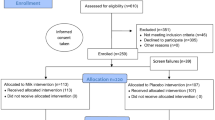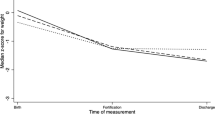Abstract
OBJECTIVE:
To reduce feeding intolerance among very low birth weight neonates.
STUDY DESIGN:
A total of 10 neonates with birth weights of 750 to 1250 g were given oral-gastric boluses (2.5 ml/kg every 3 hours) of a solution patterned after amniotic fluid. When milk feedings were begun the milk was mixed with the test solution. The solution was given at a constant daily dose of 20 ml/kg/day while the volumes of milk feedings were gradually increased. When milk feedings reached 80 ml/kg/day the test solution was discontinued. A comparison group consisted of neonates who met study criteria but were cared for during the period immediately preceding the study. The outcome was the number of calories taken enterally over the first 21 days of life.
RESULTS:
The test solution was begun an average of 27 hours after birth (range, 4 to 45). In the test group the first milk feedings were introduced 74 hours after birth (range, 18 to 144), which was similar to the time milk was introduced in the comparison subjects (79 hours; range, 18 to 168). After milk feedings were started, the test patients had a total of four NPO days (0.4 NPO days per patient) during their first 21 days, while the comparison group had 34 NPO days (3.4 NPO days per patient). During the first 14 days of life the test solution recipients had a median of 26.5 enteral cal/kg/day (range, 4.3 to 68.9), while the comparison neonates had 8.5 (range, 0.2 to 25; p<0.05). During the first 21 days of life the test solution recipients had a median of 56.9 enteral cal/kg/day (range, 11.5 to 89.4), while the comparison neonates had 19.2 (range, 0.9 to 52.8; p<0.05).
CONCLUSION:
In all, 10 VLBW infants tolerated the test solution for periods up to 14 days with no significant adverse effects. A randomized trial to determine whether this solution reduces feeding intolerance among VLBW neonates should be conducted.
This is a preview of subscription content, access via your institution
Access options
Subscribe to this journal
Receive 12 print issues and online access
$259.00 per year
only $21.58 per issue
Buy this article
- Purchase on Springer Link
- Instant access to full article PDF
Prices may be subject to local taxes which are calculated during checkout
Similar content being viewed by others
References
Bertseth CL . Feeding methods for the preterm infant. Semin Neonatol 2001;6:417–424.
Jadcherla SR, Kliegman RM . Studies of feeding intolerance in very low birth weight infants: definition and significance. Pediatrics 2002;109:516–517.
Sohn AH, Garrett DO, Sinkowitz-Cochran RL, et al. Prevalence of nosocomial infections in neonatal intensive care unit patients: results from the first national point-prevalence survey. J Pediatr 2001;139:821–827.
Hernandez G, Velasco N, Wainstein C, et al. Gut mucosal atrophy after a short enteral fasting period in critically ill patients. J Crit Care 1999;14:73–77.
Calhoun DA, Juul SE, McBryde EV, Veerman MW, Christensen RD . Stability of filgrastim and epoetin alfa in a system designed for enteral administration in neonates. Ann Pharmacother 2000;34:1257–1261.
Calhoun DA, Richards BE, Gersting JA, Sullivan SE, Christensen RD . G-CSF and Epo stability in amniotic fluid during simulated in vitro digestion conditions. J Pharm Tech 2002;18:310–315.
Calhoun DA, Lune M, Du Y, Christensen RD . Granulocyte colony-stimulating factor is present in human milk and its receptor is present in human fetal intestine. Pediatrics 2000;105:e7.
Juul S, Joyce A, Zhao Y, Ledbetter D . Why is erythropoietin present in human milk? Studies on erythropoietin receptors on enterocytes of human and rat neonates. Pediatr Res 1999;46:263–268.
Calhoun DA, Maheshwari A, Christensen RD . Recombinant granulocyte colony-stimulating factor administered enterally to neonates is not absorbed. Pediatrics 2003;112:421–423.
Juul SE, Christensen RD . Absorption of enteral recombinant human erythropoietin by neonates. Ann Pharmacother 2003;37:782–786.
Sullivan SE, Calhoun DA, Maheshwari A, et al. Tolerance of simulated amniotic fluid in premature neonates. Ann Pharmacother 2002;36:1518–1524.
Lima-Rogel V, Calhoun DA, Maheshwari A, et al. Tolerance of a sterile isotonic electrolyte solution containing select recombinant growth factors in neonates recovering from necrotizing enterocolitis. J Perinatol 2003;23:200–204.
Lima-Rogel V, Ojeda MA, Villegas G, et al. Tolerance of an enterally administered simulated amniotic fluid-like solution by neonates recovering from surgery for congenital bowel abnormalities. J Perinatol 2004;24:295–298.
Kliegman RM . Experimental validation of neonatal feeding practices. Pediatrics 1999;103:492–493.
ElHennawy AA, Sparks JW, Armentrout D, Huseby V, Berseth CL . Erythromycin fails to improve feeding outcome in feeding-intolerant preterm infants. J Pediatr Gastroenterol Nutr 2003;37:281–286.
Schanler RJ, Shulman RH, Lau C . Feeding strategies for premature infants; beneficial outcomes of feeding fortified human milk versus preterm formula. Pediatrics 1999;103:1150–1157.
Mihatsch WA, von Schoenaich P, Fahnenstich H, et al. The significance of gastric residuals in the early enteral feeding advancement of extremely low birth weight infants. Pediatrics 2002;1009:457–459.
Berseth CL, Bisquera JA, Paje VU . Prolonging small feeding volumes early in life decreases the incidence of necrotizing enterocolitis in very low birth weight infants. Pediatrics 2003;111:529–534.
Rayyis SF, Ambalavanan NM, Wright L, et al. Randomized trial of “slow” versus “fast” feed advancements on the incidence of necrotizing enterocolitis in very low birth weight infants. J Pediatr 1999;134:293–297.
Owens L, Burrin DG, Berseth CL . Minimal enteral feedings induces maturation of intestinal motor function but not mucosal growth in neonatal dogs. J Nutr 2002;132:2717–2722.
Condino AA, Barleycorn AA, Lu W, Maheshwari A, Christensen RD, Calhoun DA . Abnormal intestinal histology in neonates with congenital anomalies of the gastrointestinal tract. Biol Neonate 2004;85:145–150.
Karnak I, Tanyel F, Muftuoglu S, et al. Esophageal ligation: effects on the development of fetal organic systems. Eur J Pediatr Surg 1996;6:328–333.
Trahair J, Harding R . Restitution of swallowing in the fetal sheep restores intestinal growth after midgestation esophageal obstruction. J Pediatr Gastroenterol Nutr 1995;20:156–161.
Maheshwari A . Role of cytokines in human intestinal villous development. Clin Perinatol 2004;31:143–156.
Juul SE . Recombinant erythropoietin as a neuroprotective treatment: in vitro and in vivo models. Clin Perinatol 2004;31:129–142.
Calhoun DA, Christensen RD . Hematopoietic growth factors in neonatal medicine: the use of enterally administered hematopoietic growth factors in the neonatal intensive care unit. Clin Perinatol 2004;31:169–182.
Acknowledgements
We thank Jon T. Horn, RPH, research pharmacist at McKay Dee Hospital Center, Ogden, UT for his valuable assistance with the study. We also thank Dr. David Auerbach, Medical Director of the NICU at Arnold Palmer Hospital for Women and Children, Orlando, Florida, for serving as Chair of the Data Safety and Monitoring Board, and Dawn Bruton, Debra Patrick, Susan Stripling, and Brenda Smith for research nursing assistance. We also thank the NICU nursing staff at Intermountain Health Care and Tampa General Hospital for their assistance, and the staff at the US Food and Drug Administration for their helpful suggestions regarding the study design.
Author information
Authors and Affiliations
Rights and permissions
About this article
Cite this article
Christensen, R., Havranek, T., Gerstmann, D. et al. Enteral Administration of a Simulated Amniotic Fluid to Very Low Birth Weight Neonates. J Perinatol 25, 380–385 (2005). https://doi.org/10.1038/sj.jp.7211306
Published:
Issue Date:
DOI: https://doi.org/10.1038/sj.jp.7211306
This article is cited by
-
Protective effects of amniotic fluid in the setting of necrotizing enterocolitis
Pediatric Research (2017)
-
Standardized feeding regimen for reducing necrotizing enterocolitis in preterm infants: an updated systematic review
Journal of Perinatology (2017)
-
Pathophysiology and Current Management of Necrotizing Enterocolitis
The Indian Journal of Pediatrics (2014)
-
Necrotizing enterocolitis in term neonates: data from a multihospital health-care system
Journal of Perinatology (2007)
-
Treating feeding intolerance with an enteral solution patterned after human amniotic fluid: a randomized, controlled, masked trial
Journal of Perinatology (2007)



